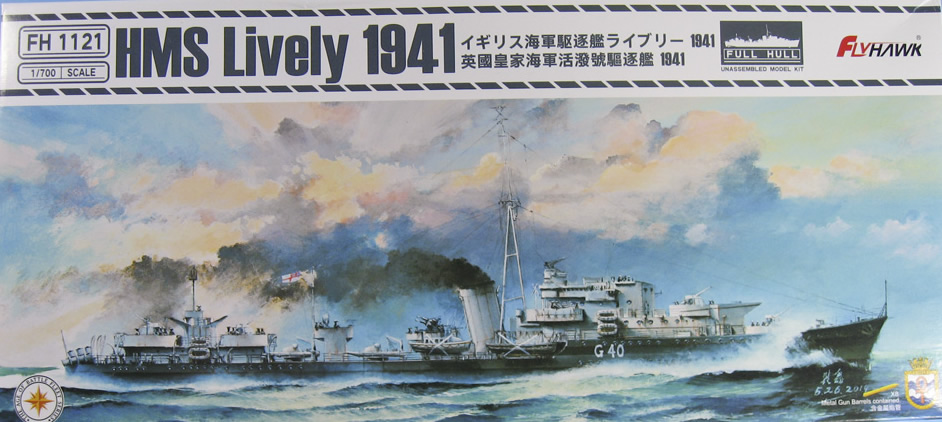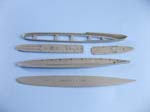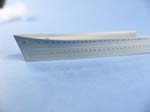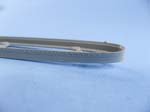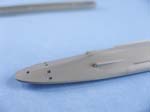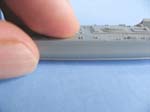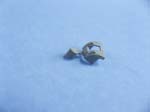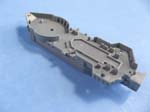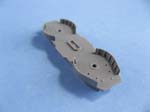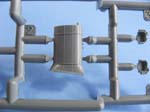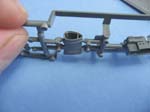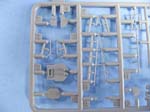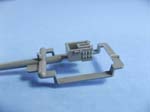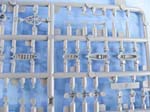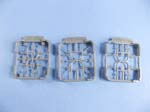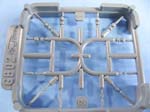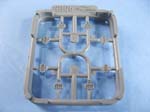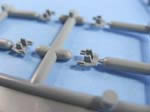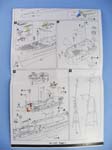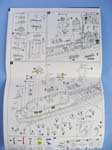| HMS
Lively, 1941
Flyhawk, FH 1121, 1/700 Scale, Injection Molded Styrene Reviewed by Devin Poore, October 2019
|
|||||||||||||
| The L and M class was a class of sixteen
destroyers which served in the British Royal Navy during World War II,
launched between 1939 and 1942. HMS Lively, a member of the L class, was
built with 4 inch main guns, as opposed to the 4.7 inch that most of the
L and M class wielded. Commissioned in 1941, Lively had a relatively short
but active wartime career. After a short stint patrolling the North Sea,
she was transferred to the Mediterranean, based out of Malta, where she
served with the Mediterranean Fleet, and Force K. She fought in both the
First and Second Battles of Sirte, before succumbing to German airstrikes
off the coast of Tobruk in May of 1942.
The Flyhawk kit comes in their standard box. Inside are the instructions, styrene parts, a bag of turned brass gun barrels, and decals. There doesn't seem to be a set order for the sprue numbering, which I know is partly because of Flyhawk's practice of putting weapons common to multiple kits on a sprue to reduce tooling and molding costs. Therefore, I'll be looking at the parts in groups as they are bagged in the kit. |
|||||||||||||
| The Hull and Decks | |||||||||||||
| The first thing that grabs the eye upon opening the box
is the foam-wrapped bundle which contains the hull and deck components.
Unwrapping, one finds the main hull, a lower hull option, a waterline plate,
and the main and foredecks. Detail is fantastic. The hull itself has a
knife-sharp bow, anchor hawse, chocks, basic plating, and rain gutters
over the portholes. There is a slight sink mark just behind the stem of
the bow, a common issue with hulls molded in one piece instead of port
and starboard halves, but it's very minimal; it shows more so in my photos
than it does to the naked eye.
The lower hull fits like a glove. I included a couple of photos of me holding the lower hull and the decks to the main hull, but I wasn't able to capture properly how well they fit. There is absolutely no gap. The same goes for a test fit of the forward superstructure to the deck. The fit is amazing. The lower hull does have a slight texture to it, something that shows up again in various areas of the deck; it isn't a mold issue, as other parts of the deck and items such as funnel, boats, weapons, etc. are perfectly smooth. It's something that isn't really noticeable to the naked eye, only really apparent in digital macro photos, so once paint is applied it shouldn't be an issue. The decks are well detailed, with the forward gun splinter shield, bitts, and other small parts molded into the deck. The splinter shields here, and on the superstructures, are extremely thin, .4mm or .015", which looks very in-scale. The only thing really missing is anchor chain, which is not molded as part of the deck, nor is any brass chain included in the kit. Sources state the full sized ship had an overall length of 110.5m or 362.5 feet. The kit's hull measures out at just over 157mm, which is spot-on for 1/700 scale. |
to enlarge |
||||||||||||
 |
|||||||||||||
|
|||||||||||||
| Parts GB, H, I and J | |||||||||||||
| The first bag contains parts for the after super structure. Present
again are extremely fine molding, those .04mm thick/thin splinter shields,
and petite yet well defined deck details: raised gun bases, hatches, portholes,
etc. Also in this batch are the gun shields for the 4" guns; the shields
have bolt detail that looks way oversized in the photos, but to the naked
eye they're just visible (the close-up photo of the gun shield below is
at least 8 times larger than the actual piece).
I did a quick test-fit of these deck structures to each other, and to the deck, which resulted, again, in not even a gap big enough to show up in macro photos. It was at this point that I realized I really want to build this kit. |
 |
||||||||||||
|
|||||||||||||
| Sprues O and F | |||||||||||||
| Sprue F had the upper section of the bridge, the search/signal light
wings that attach to it, and the stack. Extremely fine rivet detail is
just barely visible on the stack. The searchlight platforms and bridge
section are detailed with raised platforms, portholes, and other details.
Sprue O contains the mast components, rudder, anchors, screws, winches, screw shafts, and other small details. The mast is made up of 3 pieces that should go together as a fine representation of the mast. Exercise caution when removing these components, however, as the sprue attachment points are thicker than the mast itself at a few points, and may easily break. |
 |
||||||||||||
|
|||||||||||||
| Sprues L, N and P | |||||||||||||
| Sprue L is a tiny thing with 4 identical parts. I can't find mention
of them anywhere in the instructions, though. They look like either radar
screen supports, or life raft quick-release mounts. Perhaps something to
be used in future boxings of the kit?
Sprue N is for a structure midships, between the torpedo mounts, that sports a searchlight and I believe may be the aft emergency conning station, as well as additional parts for the aft superstructure. Sprue P has all of the above-deck detail goodies: ammo boxes, forward breakwater, torpedo mounts, ship's boats, and funnel top. The ship's boats are finely depicted on both the outside as well as the interior floor and seat details. Also included in this fret are stairs/ladders in the well-know "Aztec" style. It's nice to see these as separate parts, allowing those who refuse to use PE to apply them if they like, and saving those who wish to use photo etched ladders the hassle of removing them. |
 |
||||||||||||
|
|||||||||||||
| Sprue K | |||||||||||||
| This set has most of the small hardware: boat davits, mounted depth
charges, flagstaffs, pelorus (pelori?), and another small deck house. Some
of these items are often replicated with photo etch, especially in this
scale, but the depth charge assemblies and boat davits are depicted finely
enough to allow one to skip the PE. There is a sprue connection point on
the depth charges mounted to the one-piece K guns, which will require a
bit of fine cutting and sanding to remove them from the sprue.
While these parts are tiny, they have square mounting pegs on the bottom, with a corresponding hole in the ship's deck. I'm very curious to see how visible this mounting approach is once assembled and painted. |
 |
||||||||||||
|
|||||||||||||
| Sprues GB01, GB02, GB06, GB26 and GB27 | |||||||||||||
| The small weapons, searchlights and life rafts are found here. Again, the level of detail is first-rate, from the slatted bottoms of the life rafts, to the trunnions and mounts for the 4" guns. These are the common weapons sprues, so if you've seen a review of an other Flyhawk kit, or built one yourself, these are exactly the same as in those other kits. |
 |
||||||||||||
|
|||||||||||||
| Brass, Instructions and Decals | |||||||||||||
| The instructions are on a double-sided, 7 X 22" sheet. A parts list
is included, showing a line diagram, sprue identification, and how many
of each are included with the kit. The build instructions themselves are
only 7 steps, but everything appears to be included, and with the plethora
of locator pins and holes on the decks, hopefully it'll be easy enough
to sort out where everything goes.
The decals are straight-forward, including pendant numbers for several ships, and two white ensigns, one straight, one wavy. Also included in this boxing is a small bag of brass gun barrels, and one other piece that looks to be a flagstaff. The barrels are replacements for the 4" mount barrels, the brass being hollow and finer in diameter. |
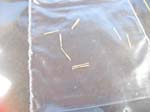
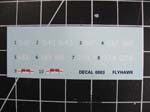 |
||||||||||||
|
|||||||||||||
| CONCLUSIONS | |||||||||||||
This kit really only needs anchor chain to complete it.
Of course railings will be wanted by most, and Flyhawk has a dedicated
photo etch set available. I'd recommend their specific set as the railings
on the foredeck will need to follow the sweep of the hull. A cursory search
of internet photos seems to indicate that this class didn't carry that
much rigging, which means that the kit's plastic masts should be fine.
Out of the box this will be an outstanding model, and if one puts in some
photo etch and extra work, it should result in a stunning model.

This is the nicest molded kit I have ever seen. The detail boggles the mind, and I honestly can't see how anyone will be able to beat its fidelity. I was only passingly aware of this class of ship when I received this review sample, and had no desire to build one. Now that I've studied this model for the review, and seen how well things fit just by stacking components, I'm anxious to start building this kit. Highly recommended. Thank you to Flyhawk for the review sample. |
|||||||||||||
